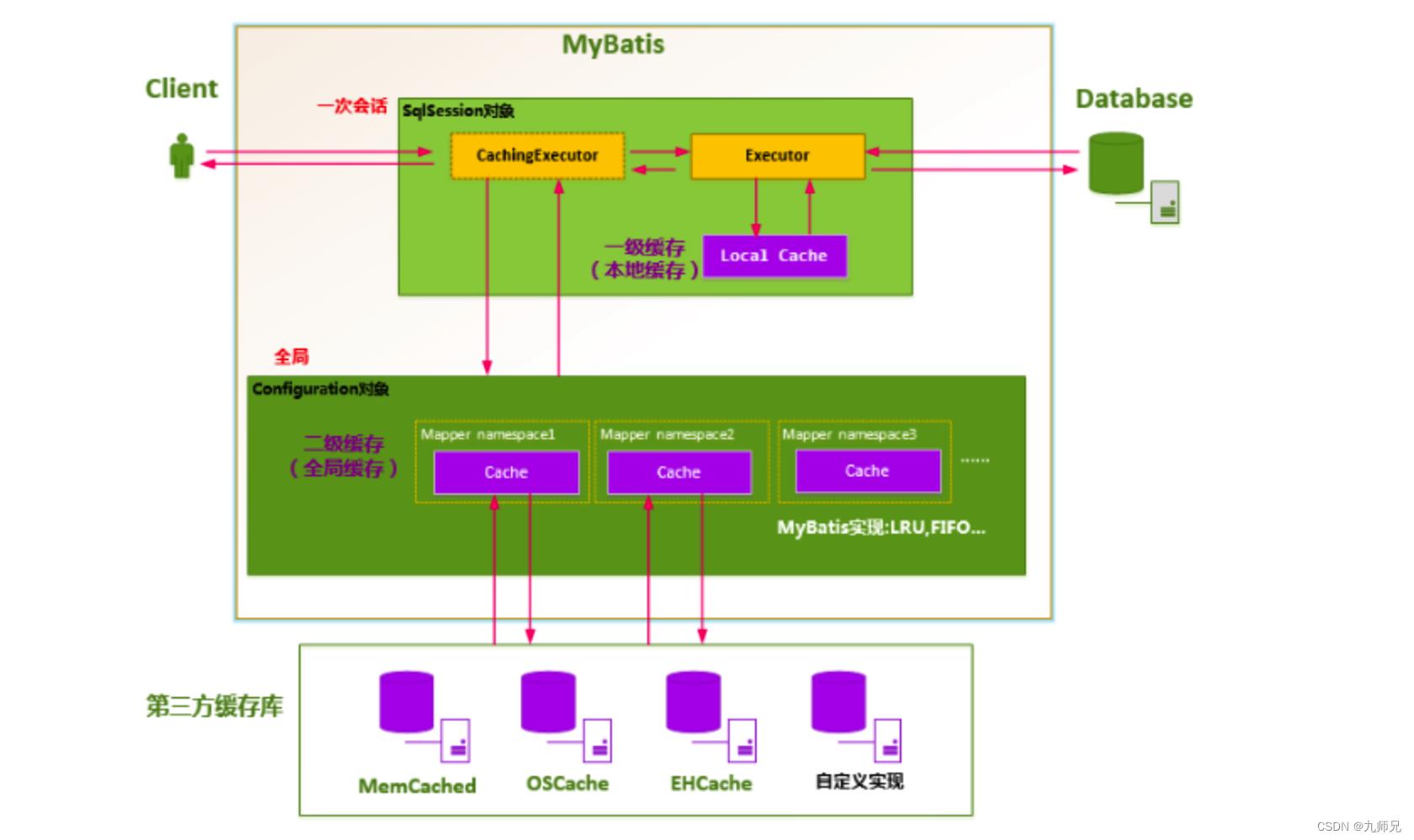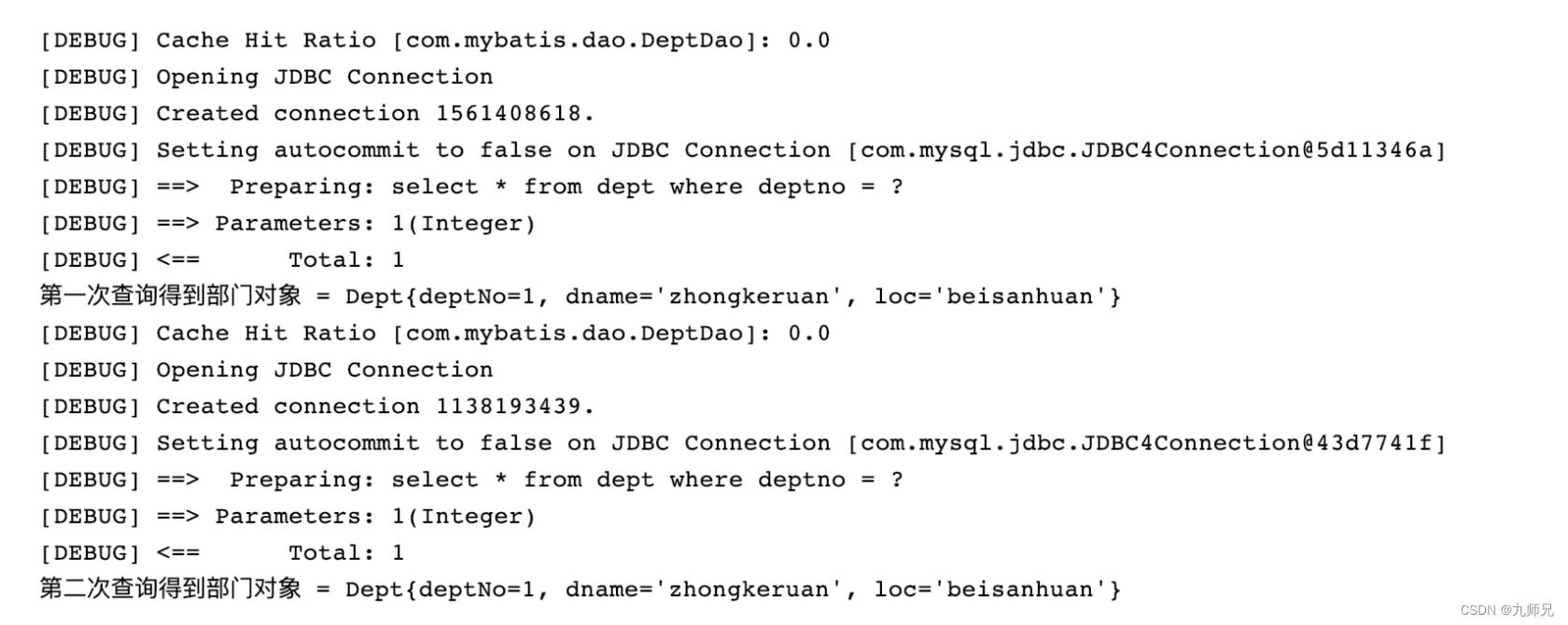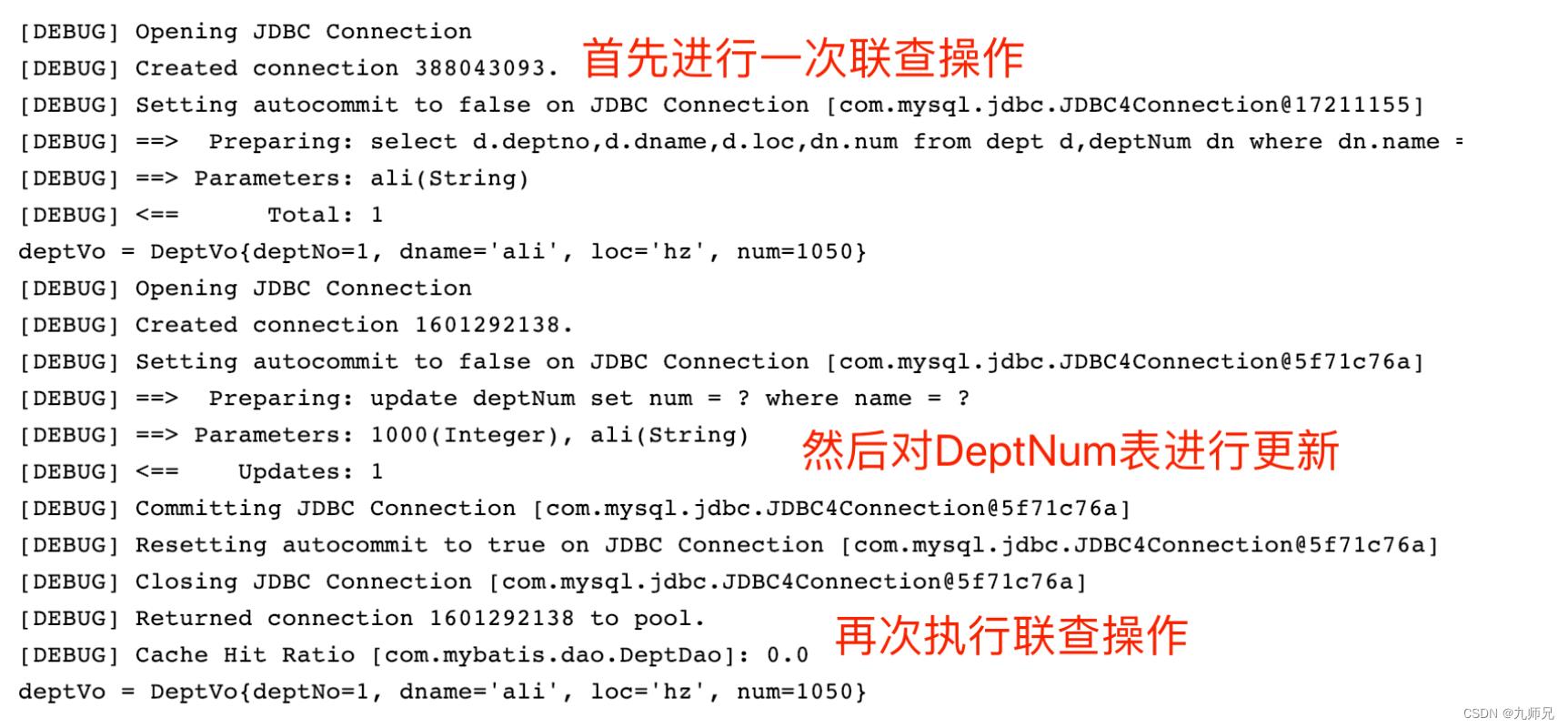MyBatisMyBatis 二级缓存全详解
Posted 九师兄
tags:
篇首语:本文由小常识网(cha138.com)小编为大家整理,主要介绍了MyBatisMyBatis 二级缓存全详解相关的知识,希望对你有一定的参考价值。

1.概述
上一篇文章中我们介绍到了 MyBatis 一级缓存其实就是 SqlSession 级别的缓存,什么是 SqlSession 级别的缓存呢?一级缓存的本质是什么呢? 以及一级缓存失效的原因?我希望你在看下文之前能够回想起来这些内容。
MyBatis 一级缓存最大的共享范围就是一个SqlSession内部,那么如果多个 SqlSession 需要共享缓存,则需要开启二级缓存,开启二级缓存后,会使用 CachingExecutor 装饰 Executor,进入一级缓存的查询流程前,先在CachingExecutor 进行二级缓存的查询,具体的工作流程如下所示

当二级缓存开启后,同一个命名空间(namespace) 所有的操作语句,都影响着一个共同的 cache,也就是二级缓存被多个 SqlSession 共享,是一个全局的变量。当开启缓存后,数据的查询执行的流程就是 二级缓存 -> 一级缓存 -> 数据库。
2.二级缓存开启条件
二级缓存默认是不开启的,需要手动开启二级缓存,实现二级缓存的时候,MyBatis要求返回的POJO必须是可序列化的。开启二级缓存的条件也是比较简单,通过直接在 MyBatis 配置文件中通过
<settings>
<setting name = "cacheEnabled" value = "true" />
</settings>
来开启二级缓存,还需要在 Mapper 的xml 配置文件中加入 <cache> 标签
设置 cache 标签的属性
cache 标签有多个属性,一起来看一些这些属性分别代表什么意义
eviction: 缓存回收策略,有这几种回收策略
LRU- 最近最少回收,移除最长时间不被使用的对象FIFO- 先进先出,按照缓存进入的顺序来移除它们SOFT- 软引用,移除基于垃圾回收器状态和软引用规则的对象WEAK- 弱引用,更积极的移除基于垃圾收集器和弱引用规则的对象
默认是 LRU 最近最少回收策略
-
flushinterval缓存刷新间隔,缓存多长时间刷新一次,默认不清空,设置一个毫秒值 -
readOnly: 是否只读;true 只读,MyBatis 认为所有从缓存中获取数据的操作都是只读操作,不会修改数据。MyBatis 为了加快获取数据,直接就会将数据在缓存中的引用交给用户。不安全,速度快。读写(默认):MyBatis 觉得数据可能会被修改 -
size: 缓存存放多少个元素 -
type: 指定自定义缓存的全类名(实现Cache 接口即可) -
blocking: 若缓存中找不到对应的key,是否会一直blocking,直到有对应的数据进入缓存。
3.探究二级缓存
我们继续以 MyBatis 一级缓存文章中的例子为基础,搭建一个满足二级缓存的例子,来对二级缓存进行探究,例子如下(对 一级缓存的例子部分源码进行修改):
Dept.java
//存放在共享缓存中数据进行序列化操作和反序列化操作
//因此数据对应实体类必须实现【序列化接口】
public class Dept implements Serializable
private Integer deptNo;
private String dname;
private String loc;
public Dept()
public Dept(Integer deptNo, String dname, String loc)
this.deptNo = deptNo;
this.dname = dname;
this.loc = loc;
get and set...
@Override
public String toString()
return "Dept" +
"deptNo=" + deptNo +
", dname='" + dname + '\\'' +
", loc='" + loc + '\\'' +
'';
myBatis-config.xml
在myBatis-config 中添加开启二级缓存的条件
<!-- 通知 MyBatis 框架开启二级缓存 -->
<settings>
<setting name="cacheEnabled" value="true"/>
</settings>
DeptDao.xml
还需要在 Mapper 对应的xml中添加 cache 标签,表示对哪个mapper 开启缓存
<!-- 表示DEPT表查询结果保存到二级缓存(共享缓存) -->
<cache/>
对应的二级缓存测试类如下:
public class MyBatisSecondCacheTest
private SqlSession sqlSession;
SqlSessionFactory factory;
@Before
public void start() throws IOException
InputStream is = Resources.getResourceAsStream("myBatis-config.xml");
SqlSessionFactoryBuilder builderObj = new SqlSessionFactoryBuilder();
factory = builderObj.build(is);
sqlSession = factory.openSession();
@After
public void destory()
if(sqlSession!=null)
sqlSession.close();
@Test
public void testSecondCache()
//会话过程中第一次发送请求,从数据库中得到结果
//得到结果之后,mybatis自动将这个查询结果放入到当前用户的一级缓存
DeptDao dao = sqlSession.getMapper(DeptDao.class);
Dept dept = dao.findByDeptNo(1);
System.out.println("第一次查询得到部门对象 = "+dept);
//触发MyBatis框架从当前一级缓存中将Dept对象保存到二级缓存
sqlSession.commit();
// 改成 sqlSession.close(); 效果相同
SqlSession session2 = factory.openSession();
DeptDao dao2 = session2.getMapper(DeptDao.class);
Dept dept2 = dao2.findByDeptNo(1);
System.out.println("第二次查询得到部门对象 = "+dept2);
测试二级缓存效果,提交事务,sqlSession查询完数据后,sqlSession2相同的查询是否会从缓存中获取数据。
通过结果可以得知,首次执行的SQL语句是从数据库中查询得到的结果,然后第一个 SqlSession 执行提交,第二个 SqlSession 执行相同的查询后是从缓存中查取的。
用一下这幅图能够比较直观的反映两次 SqlSession 的缓存命中

4.二级缓存失效的条件
与一级缓存一样,二级缓存也会存在失效的条件的,下面我们就来探究一下哪些情况会造成二级缓存失效
4.1 第一次SqlSession 未提交
SqlSession 在未提交的时候,SQL 语句产生的查询结果还没有放入二级缓存中,这个时候 SqlSession2 在查询的时候是感受不到二级缓存的存在的,修改对应的测试类,结果如下:
@Test
public void testSqlSessionUnCommit()
//会话过程中第一次发送请求,从数据库中得到结果
//得到结果之后,mybatis自动将这个查询结果放入到当前用户的一级缓存
DeptDao dao = sqlSession.getMapper(DeptDao.class);
Dept dept = dao.findByDeptNo(1);
System.out.println("第一次查询得到部门对象 = "+dept);
//触发MyBatis框架从当前一级缓存中将Dept对象保存到二级缓存
SqlSession session2 = factory.openSession();
DeptDao dao2 = session2.getMapper(DeptDao.class);
Dept dept2 = dao2.findByDeptNo(1);
System.out.println("第二次查询得到部门对象 = "+dept2);
产生的输出结果:

4.2 更新对二级缓存影响
与一级缓存一样,更新操作很可能对二级缓存造成影响,下面用三个 SqlSession来进行模拟,第一个 SqlSession 只是单纯的提交,第二个 SqlSession 用于检验二级缓存所产生的影响,第三个 SqlSession 用于执行更新操作,测试如下:
@Test
public void testSqlSessionUpdate()
SqlSession sqlSession = factory.openSession();
SqlSession sqlSession2 = factory.openSession();
SqlSession sqlSession3 = factory.openSession();
// 第一个 SqlSession 执行更新操作
DeptDao deptDao = sqlSession.getMapper(DeptDao.class);
Dept dept = deptDao.findByDeptNo(1);
System.out.println("dept = " + dept);
sqlSession.commit();
// 判断第二个 SqlSession 是否从缓存中读取
DeptDao deptDao2 = sqlSession2.getMapper(DeptDao.class);
Dept dept2 = deptDao2.findByDeptNo(1);
System.out.println("dept2 = " + dept2);
// 第三个 SqlSession 执行更新操作
DeptDao deptDao3 = sqlSession3.getMapper(DeptDao.class);
deptDao3.updateDept(new Dept(1,"ali","hz"));
sqlSession3.commit();
// 判断第二个 SqlSession 是否从缓存中读取
dept2 = deptDao2.findByDeptNo(1);
System.out.println("dept2 = " + dept2);
对应的输出结果如下

5.探究多表操作对二级缓存的影响
现有这样一个场景,有两个表,部门表dept(deptNo,dname,loc)和 部门数量表deptNum(id,name,num),其中部门表的名称和部门数量表的名称相同,通过名称能够联查两个表可以知道其坐标(loc)和数量(num),现在我要对部门数量表的 num 进行更新,然后我再次关联dept 和 deptNum 进行查询,你认为这个 SQL 语句能够查询到的 num 的数量是多少?来看一下代码探究一下
DeptNum.java
public class DeptNum
private int id;
private String name;
private int num;
get and set...
DeptVo.java
public class DeptVo
private Integer deptNo;
private String dname;
private String loc;
private Integer num;
public DeptVo(Integer deptNo, String dname, String loc, Integer num)
this.deptNo = deptNo;
this.dname = dname;
this.loc = loc;
this.num = num;
public DeptVo(String dname, Integer num)
this.dname = dname;
this.num = num;
get and set
@Override
public String toString()
return "DeptVo" +
"deptNo=" + deptNo +
", dname='" + dname + '\\'' +
", loc='" + loc + '\\'' +
", num=" + num +
'';
DeptDao.java
public interface DeptDao
...
DeptVo selectByDeptVo(String name);
DeptVo selectByDeptVoName(String name);
int updateDeptVoNum(DeptVo deptVo);
DeptDao.xml
<select id="selectByDeptVo" resultType="com.mybatis.beans.DeptVo">
select d.deptno,d.dname,d.loc,dn.num from dept d,deptNum dn where dn.name = d.dname
and d.dname = #name
</select>
<select id="selectByDeptVoName" resultType="com.mybatis.beans.DeptVo">
select * from deptNum where name = #name
</select>
<update id="updateDeptVoNum" parameterType="com.mybatis.beans.DeptVo">
update deptNum set num = #num where name = #dname
</update>
DeptNum 数据库初始值:

测试类对应如下:
/**
* 探究多表操作对二级缓存的影响
*/
@Test
public void testOtherMapper()
// 第一个mapper 先执行联查操作
SqlSession sqlSession = factory.openSession();
DeptDao deptDao = sqlSession.getMapper(DeptDao.class);
DeptVo deptVo = deptDao.selectByDeptVo("ali");
System.out.println("deptVo = " + deptVo);
// 第二个mapper 执行更新操作 并提交
SqlSession sqlSession2 = factory.openSession();
DeptDao deptDao2 = sqlSession2.getMapper(DeptDao.class);
deptDao2.updateDeptVoNum(new DeptVo("ali",1000));
sqlSession2.commit();
sqlSession2.close();
// 第一个mapper 再次进行查询,观察查询结果
deptVo = deptDao.selectByDeptVo("ali");
System.out.println("deptVo = " + deptVo);
测试结果如下:

在对DeptNum 表执行了一次更新后,再次进行联查,发现数据库中查询出的还是 num 为 1050 的值,也就是说,实际上 1050 -> 1000 ,最后一次联查实际上查询的是第一次查询结果的缓存,而不是从数据库中查询得到的值,这样就读到了脏数据。
解决办法
如果是两个mapper命名空间的话,可以使用 <cache-ref>来把一个命名空间指向另外一个命名空间,从而消除上述的影响,再次执行,就可以查询到正确的数据
6.二级缓存源码解析
源码模块主要分为两个部分:二级缓存的创建和二级缓存的使用,首先先对二级缓存的创建进行分析:
6.1 二级缓存的创建
二级缓存的创建是使用 Resource 读取 XML 配置文件开始的
InputStream is = Resources.getResourceAsStream("myBatis-config.xml");
SqlSessionFactoryBuilder builder = new SqlSessionFactoryBuilder();
factory = builder.build(is);
读取配置文件后,需要对XML创建 Configuration并初始化
XMLConfigBuilder parser = new XMLConfigBuilder(inputStream, environment, properties);
return build(parser.parse());
调用 parser.parse() 解析根目录 /configuration 下面的标签,依次进行解析
public Configuration parse()
if (parsed)
throw new BuilderException("Each XMLConfigBuilder can only be used once.");
parsed = true;
parseConfiguration(parser.evalNode("/configuration"));
return configuration;
private void parseConfiguration(XNode root)
try
//issue #117 read properties first
propertiesElement(root.evalNode("properties"));
Properties settings = settingsAsProperties(root.evalNode("settings"));
loadCustomVfs(settings);
typeAliasesElement(root.evalNode("typeAliases"));
pluginElement(root.evalNode("plugins"));
objectFactoryElement(root.evalNode("objectFactory"));
objectWrapperFactoryElement(root.evalNode("objectWrapperFactory"));
reflectorFactoryElement(root.evalNode("reflectorFactory"));
settingsElement(settings);
// read it after objectFactory and objectWrapperFactory issue #631
environmentsElement(root.evalNode("environments"));
databaseIdProviderElement(root.evalNode("databaseIdProvider"));
typeHandlerElement(root.evalNode("typeHandlers"));
mapperElement(root.evalNode("mappers"));
catch (Exception e)
throw new BuilderException("Error parsing SQL Mapper Configuration. Cause: " + e, e);
其中有一个二级缓存的解析就是
mapperElement(root.evalNode("mappers"));
然后进去 mapperElement 方法中
XMLMapperBuilder mapperParser = new XMLMapperBuilder(inputStream, configuration, resource, configuration.getSqlFragments());
mapperParser.parse();
继续跟 mapperParser.parse() 方法
public void parse()
if (!configuration.isResourceLoaded(resource))
configurationElement(parser.evalNode("/mapper"));
configuration.addLoadedResource(resource);
bindMapperForNamespace();
parsePendingResultMaps();
parsePendingCacheRefs();
parsePendingStatements();
这其中有一个 configurationElement 方法,它是对二级缓存进行创建,如下
private void configurationElement(XNode context)
try
String namespace = context.getStringAttribute("namespace");
if (namespace == null || namespace.equals(""))
throw new BuilderException("Mapper's namespace cannot be empty");
builderAssistant.setCurrentNamespace(namespace);
cacheRefElement(context.evalNode("cache-ref"));
cacheElement(context.evalNode("cache"));
parameterMapElement(context.evalNodes("/mapper/parameterMap"));
resultMapElements(context.evalNodes("/mapper/resultMap"));
sqlElement(context.evalNodes("/mapper/sql"));
buildStatementFromContext(context.evalNodes("select|insert|update|delete"));
catch (Exception e)
throw new BuilderException("Error parsing Mapper XML. Cause: " + e, e);
有两个二级缓存的关键点
cacheRefElement(context.evalNode("cache-ref"));
cacheElement(context.evalNode("cache"));
也就是说,mybatis 首先进行解析的是 cache-ref 标签,其次进行解析的是 cache 标签。
根据上面我们的 — 多表操作对二级缓存的影响 一节中提到的解决办法,采用 cache-ref 来进行命名空间的依赖能够避免二级缓存,但是总不能每次写一个 XML 配置都会采用这种方式吧,最有效的方式还是避免多表操作使用二级缓存
然后我们再来看一下cacheElement(context.evalNode("cache")) 这个方法
private void cacheElement(XNode context) throws Exception
if (context != null)
String type = context